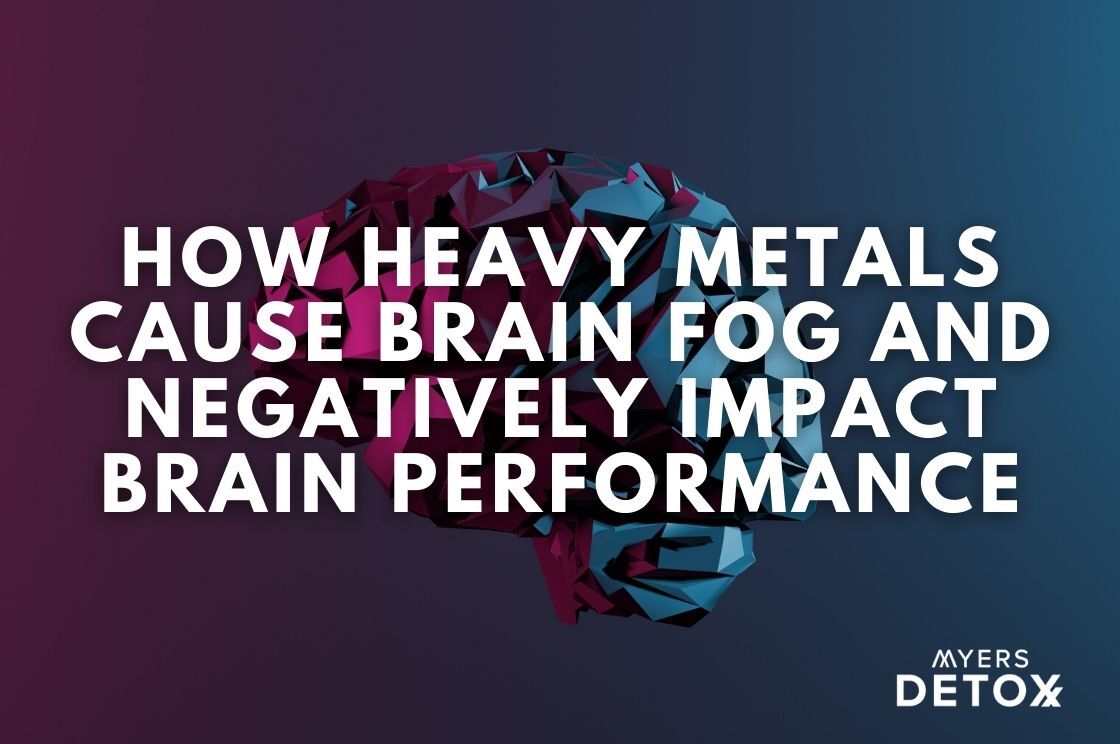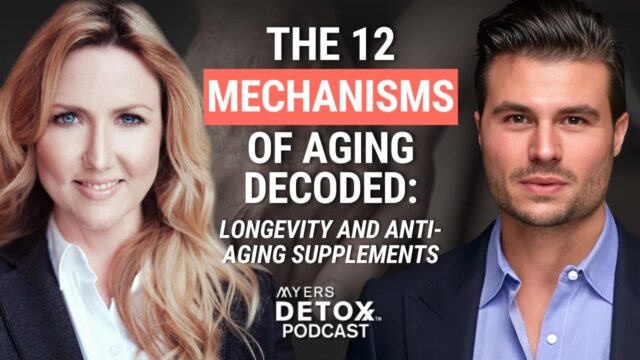Exposure to heavy metals can negatively impact brain performance. They contribute to the decrease in your energy production (needed for brain function), affects neurotransmission (how you think) and your ability to focus. In this article I will examine how toxic metals impact your brain’s performance and what you can do about it!
What is Brain fog?
Brain fog is cognitive dysfunction involving:
- Lack of mental clarity
- Recall and memory difficulty
- Poor focus
- Poor concentration
Depending on the severity of brain fog, it can interfere with one’s ability to work or school. But there are many ways you can fix this problem that baffles doctors.
Causes of Brain Fog
Brain fog can have multiple causes, including:
- Heavy metal toxicity involving aluminum, lead, mercury, tin and others interfere in brain function in a number of ways listed below.
- Mitochondrial dysfunction – Mitochondria produce energy. The brain uses 20% of the body’s energy production. Low energy production equals low brain function.
- Medications, mostly commonly blood pressure medications and statins. My brilliant father suffered terribly from statin-related brain fog. (1, 2)
- Hormonal changes. Heavy metals and other toxins dramatically interfere in hormone production and reception. A drop in estrogen levels during menopause can cause forgetfulness, poor concentration, and cloudy thinking.
- Diet, including poor nutrition and food sensitivities. Brain fog may develop after eating certain foods to which you are sensitive.
Heavy Metals and Brain Function
Heavy metals cause brain fog and impair brain performance in several ways. Mitochondrial dysfunction, oxidative stress and microglial activation (think brain inflammation) all combine to impair the capacity of brain cells to maintain normal cognitive processing. These issues affect such things as short-term memory, concentration and decision making. (3, 4, 5, 6, 7)
Heavy metals act via several different mechanisms in brain tissue:
1. Cellular destruction – tin kills off cerebellar neurons; mercury destroys cellular infrastructure (neurofibrils) within nerve cells and inhibits neurite formation. (8, 9)
2. Oxidative stress– heavy metals reduces cellular glutathione levels and generate lots of free radicals. Glutathione is the body’s master antioxidant as is essential in detoxing the body of heavy metals. Free radicals destroy brain tissue and damage DNA. (10, 11)
3. Mitochondrial dysfunction –The brain uses up to 20 percent of the body’s energy output. Our mitochondria produce our body’s energy. Naturally, if mitochondria are not working properly and energy production is low, brain performance will suffer. There are certain toxic metals that cause fatigue by interfering in mitochondrial energy production. Mitochondrial dysfunction from arsenic, aluminum, tin, thallium and cesium reduce energy (ATP) supply to neurons, astrocytes and other brain cells. (12, 13, 14)
4. Microglial activation –The inflammatory response in the brain is mediated by activated microglia, the resident immune cells of the central nervous system. Activation of microglia is a hallmark of brain pathology. Aluminum especially causes microglial activation and resultant cognitive dysfunction and brain fog.
5. Interference with neurotransmission – many different metals reduce levels of neurotransmitters e.g. serotonin, dopamine and GABA. (15, 16)
6. Interference with hypothalamic function – especially the production of Antidiuretic Hormone (vasopressin) (mercury) and blockage of melatonin receptors causing chronic sleep disturbance. (17)
7. Generation of both beta-amyloid and tau proteins in susceptible individuals. (18, 19)
Toxic Metals That Impair Brain Function
1. Mercury is deposited throughout the brain, especially in the hypothalamus (thyroid signaling) and hippocampus (memory and emotions). It is also found throughout the cortex and occipital lobe.
2. Lead has been known for many years as a neurotoxin, especially in children. It lowers IQ and like mercury, impairs working memory. It interferes with the processes of learning and is also associated with behavioral disturbances in children. It is also associated with fatigue, mood issues, and brain fog.
3. Aluminum. Once aluminum enters brain cells, certain people will be unable to eliminate it efficiently, thereby inducing oxidative stress and cellular damage. In older individuals, such damage may be permanent.
4. Tin affects balance mechanisms in the cerebellum (and possibly inner ear) as well as causing general fatigue. (9)
5. Manganese can build up to high level that then become neurotoxic, inducing a Parkinson’s disease-like syndrome (Manganism). Many become manganese toxic from their well water. (20)
6. Copper toxicity. Avoiding overexposure to copper is important for maintaining normal brain function. Exposure to copper may cause neurons to overfire and overproduce stimulating neurotransmitters. (21, 22)
7. Iron toxicity. Avoiding overexposure to iron may support brain health. (23)
How to Keep Your Brain Healthy and Protect It From Toxins That Lead to Brain Fog
As we’ve been discussing here, exposure to heavy metals can negatively impact brain performance.
Supporting your body’s ability to naturally avoid absorbing the offending metals, as well as providing proper nutritional support are essential for regaining one’s normal brain functioning.
Maintaining normal brain function and supporting clear thinking requires keeping your mitochondria healthy. This is because energy production is needed for proper brain function. And exposure to heavy metals can directly affect your mitochondria.
Toxic metals may cause mitochondrial dysfunction and are a major reason you’re experiencing exhaustion and lowered brain performance as a result. In fact, mitochondria may be the earliest target of metal neurotoxicity.
In this guide I will examine how heavy metals can impact brain performance, as well as the steps you can take to protect your brain by supporting good mitochondrial health!
That’s why I created a simple 2-step system to help you maintain your mitochondrial health by supporting your body remove metals that impair energy production. It’s called the Mitochondria Detox.
The Mitochondria Detox protocol supports your body’s natural ability to mobilize intruders, bind and keep them from being absorbed by your system, and directs your cells to repair themselves normally.
The first product in my system is called Ageless AF. Ageless AF contains four powerful ingredients that synergistically work together to create this powerful detox boosting, anti-aging, and beauty-enhancing formula:
- Orthosilicic acid (OSA) — this form of activated silica is the most bioavailable, highest absorbing form of silica. It can help facilitate the body’s natural excretion of the pollutants from your system that mess with your energy production and is incredibly effective at supporting your body’s natural ability to keep the body’s toxic metal burden low.
- Selenium – a potent antioxidant to fend off oxidative stress.
- Hyaluronic acid (HA) – helps your cells retain moisture for dewey, glowing skin.
- Biotin – crucial for the production of keratin, a protein that acts like the building blocks of strong hair and nails.
Ageless AF is gentle on the system and works to keep a range of trivalentmetals including thallium, aluminum, arsenic, bismuth, tin and cesium – out of the body so that you can maintain normal health an optimal brain performance.
When supporting your body’s natural ability to mobilize these toxins and keep them from being absorbed by your tissues, it’s wise to use a binder to help ensure that they are flushed out normally. This helps prevent the contaminants from being reabsorbed or redistributed elsewhere in the body
For this purpose, I use my CitriCleanse grapefruit citrus pectin.
The grapefruit citrus pectin in CitriCleanse is amazingly effective at aiding your body’s innate ability to mobilize and excrete these impurities. Grapefruit citrus pectin has been processed in a way that makes its molecules small enough to cross the intestinal barrier and to get into the bloodstream. This allows the grapefruit citrus pectin to gently surround and support the excretion of contaminants that are both freely circulating in your bloodstream as well the ones that have become lodged in tissues and organs.
In addition to this digestible grapefruit citrus pectin, Citirclenase also contains fulvic humic acid and cilantro extract for optimal support for your body’s natural detox mechanisms.
The cilantro extract supports the body’s natural excretion of harmful environmental pollutants that interfere with your health. The grapefruit pectin can gently surround the contaminants circulating in your bloodstream – as well as those lodged in your tissues and organs – and accelerate their natural removal. And fulvic minerals help with remineralizing, as well as the overall detoxification process.
You can get both of these products, including instructions on how to use them for the most effective heavy metal detox support, at MitochondriaDetox.com.
Together, Ageless AF and CitriCleanse are an easy-to-use, effective system that supports your body’s natural ability to mobilize mitochondria-damaging intruders, while also keeping them from being absorbed by your system, and directing your cells to repair themselves normally. By utilizing this system you can help your body fend off the heavy metals that lead to brain fog.
I hope this article helped to clarify why you may be experiencing brain fog. I assure you it’s not your age! The toxins in our environment, of which only a few that inhibit brain function are mentioned in this article, play a major role in our brain’s ability to process information and interfere with the large amounts of energy needed to keep our brain running.
You CAN take back control of your brain and think clearly again. I dramatically improved my brain performance with the power of detox. And want to help you do the same!
*These statements have not been reviewed by the FDA. The information herein is not intended to diagnose, treat, cure, or prevent any disease. Nor is it meant to replace or act as a substitute for speaking to a medical doctor and/or licensed health practitioner. Any products discussed are not intended to diagnose, treat, cure, or prevent any disease. They are not intended to replace any medication, medical test(s), or healing modality prescribed by your medical doctor. Please consult with your doctor before beginning a new supplement regimen.
SaveSave
SaveSave
SaveSave
SaveSave
SaveSave
SaveSave
SaveSave
SaveSave
SaveSave
SaveSave
SaveSave
SaveSave
SaveSave










